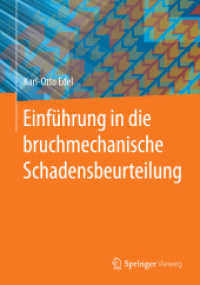Description
(Table of content)
I: The alkali metal ions in isolated systems and tissues.- I. General introduction.- II. Physical and chemical properties of the alkali metal ions.- III. Role of alkali metal ions in enzymatic processes.- IV. Effect of alkali metal ions on mitochondria.- V. Metabolic effects on tissues and tissue slices.- VI. Distribution of the alkali metal ions between cells and their surroundings.- VII. Active and passive transport of the alkali metal ions.- VIII. Relation of the alkali metal ions to bioelectric phenomena.- IX. Role of the alkali metal ions in muscular contraction.- Part: II The alkali metal ions in the organism.- I. Introduction.- II. Distribution of alkali metals in body compartments and tissues.- Author Index.14. Urease.- c) Non-specific effects of alkali metal ions.- d) Comments.- IV. Effect of alkali metal ions on mitochondria.- V. Metabolic effects on tissues and tissue slices.- a) Effects on oxygen consumption.- 1. Brain slices.- 2. Peripheral nerve.- 3. Liver slices.- 4. Muscle.- 5. Kidney slices.- 6. Isolated frog skin.- b) Effects on glycolysis.- c) Effect on acetyl choline synthesis.- d) Effect on glycogen synthesis.- e) Effects on fatty acid metabolism.- f) Effects on cellular accumulation of various substances.- g) Morphogenetic effects of lithium.- 1. The effects of lithium.- 2. Mechanism of the Li effect.- VI. Distribution of the alkali metal ions between cells and their surroundings.- a) General remarks.- b) State of potassium in living cells.- c) State of Rb and Cs in living cells.- d) State of sodium in living cells.- VII. Active and passive transport of the alkali metal ions.- A. Characterization and biological role.- a) Introduction.- b) Passive transport.- c) "Simple" passive transport.- d) The flux ratio.- e) The effect of solvent drag.- f) Passive permeability and membrane structure.- g) Permeability of intercellular cements.- h) Ionic permeability and the development of bioelectric potentials.- i) Active transport of the alkali metal ions (The "Sodium pump").- j) Relation of the active transport to metabolism.- k) Quantitative relationship between oxygen consumption and active ion transport.- 1) Temperature dependency of the "sodium pump".- m) Effects of drugs and hormones on active and passive transport.- 1. Steroid hormones.- 2. Cardiac glycosides and their aglucones.- 3. Different Hormones.- Acetyl choline.- Histamine.- Adrenaline.- Neurohypophyseal hormones.- n) Role of alkali ion transport in the regulation of the volume of living cells.- o) Mechanisms proposed for the active transport of alkali metal ions.- 1. Simple membrane-carrier transport.- 2. Electron-linked carrier transport.- 3. Propelled carrier transport.- 4. "Asymmetrically collapsing lattice" theories.- 5. The fluid circuit mechanisms.- 6. Pinocytosis.- B. Transport between cells and their surroundings.- a) Erythrocytes.- 1. Transport of potassium in human erythrocytes.- 2. Transport of sodium in human erythrocytes.- 3. Effect of pH on the Na transport.- 4. Effect of temperature.- 5. Transport of Li in human erythrocytes.- 6. Transport of Rb in human erythrocytes.- 7. Transport of Cs in human erythrocytes.- 8. Evidence for a coupling between active sodium extrusion and potassium uptake.- 9. Relation of the active and passive transports to metabolism.- 10. Effects of cardiac glucosides on the transport processes.- 11. Ion transport by red cell "ghosts".- 12. Mechanism of the active transport.- 13. Nature of the diffusion of alkali metal ions through the erythrocyte membrane.- 14. Alkali metal ion transport in other mammalian red cells.- 15. Transport of K and Na in bird red cells.- 16. Transport of K and Na in red cells of lower vertebrates.- b) Muscle.- 1. Development of the "sodium pump" concept.- 2. Net transports of K and Na in muscle.- 3. The sodium flux across the frog-muscle fibre membrane.- 4. Energy requirement of the active Na transport in frog muscle.- 5. The potassium fluxes of frog muscle.- 6. The potassium fluxes of mammalian muscle.- 7. Alkali metal ion shifts in relation to muscular activity.- c) Peripheral nerve.- 1. Movements of potassium and sodium in the resting nerve.- 2. Effect of temperature on cation fluxes in nerve.- 3. Active transport of Na in cephalopod giant axons.- 4. Coupling between Na-outflux and K-influx.- 5. Nature of the passive movement of K through the cephalopod giant axon membrane.- 6. Passive potassium transport during current flow.- 7. Passive transport of Na through the giant fibre membrane.- 8. Potassium and sodium shifts during activity.- d) Leucocytes.- e) Brain slices and isolated retina.- f) Mouse ascites carcinoma cells.- g) Liver slices.- h) Kidney cortex slices.- i) Seminal
Contents
I: The alkali metal ions in isolated systems and tissues.- I. General introduction.- II. Physical and chemical properties of the alkali metal ions.- III. Role of alkali metal ions in enzymatic processes.- IV. Effect of alkali metal ions on mitochondria.- V. Metabolic effects on tissues and tissue slices.- VI. Distribution of the alkali metal ions between cells and their surroundings.- VII. Active and passive transport of the alkali metal ions.- VIII. Relation of the alkali metal ions to bioelectric phenomena.- IX. Role of the alkali metal ions in muscular contraction.- Part: II The alkali metal ions in the organism.- I. Introduction.- II. Distribution of alkali metals in body compartments and tissues.- Author Index.







